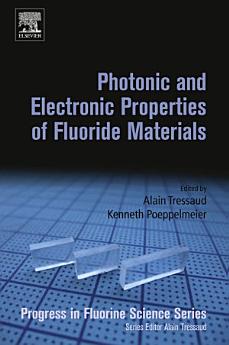Photonic and Electronic Properties of Fluoride Materials: Progress in Fluorine Science Series
About this ebook
About the author
Alain Tressaud is Emeritus Research Director at ICMCB-CNRS, Bordeaux University. He is President of the European Academy of Science in Brussels and member of several European academies. He founded and chaired the French Network on Fluorine Chemistry, sponsored by CNRS, until 2008. He has received several awards, including the CEA Award of French Academy of Sciences (2008), the Fluorine Award of the American Chemical Society (2011), and the International Henri Moissan Prize (2013). His scientific interest covers various fields, including synthesis, physical chemical characterizations, applications in fluorine chemistry, solid state chemistry, and materials sciences. His work also deals with surface modification of materials and intercalation chemistry. Professor Tressaud’s scientific production includes more than 360 papers in international journals, 20 book chapter contributions, and 12 internationalized patents. He has also edited several books in his role as editor-in-chief of the series “Advances in Fluorine Science” (2006) and “Progress in Fluorine Science” (2016) with Elsevier.
Kenneth Poeppelmeier studied chemistry at the University of Missouri-Columbia from 1967 to 1971 (B.S. Chemistry). From 1971 to 1974, he was an Instructor in Chemistry at Samoa College in Western Samoa as a United States Peace Corps volunteer. He joined the research group of John Corbett at Iowa State University after leaving the Peace Corps and received his Ph.D. in 1978. He then joined the research staff of Exxon Research and Engineering Company, Corporate Research Science Laboratory, where he worked with John Longo and Allan Jacobson on the synthesis and characterization of mixed metal oxides and their application in heterogeneous catalysis. He joined the chemistry faculty of Northwestern University in 1984 where he is now the Charles E. and Emma H. Morrison Professor of Chemistry at Northwestern University and a NAISE Fellow joint with Northwestern University and the Chemical Sciences and Engineering Division-Argonne National Laboratory. He has published over 500 papers (1971-2023) and supervised over 200 undergraduates, PhD students, postdocs and visiting scholars. Leadership positions held include Director, Center for Catalysis and Surface Science Northwestern University, Associate Division Director for Science, Chemical Sciences and Engineering Division-Argonne National Laboratory, president of the Chicago Area Catalysis Club, Associate Director- NSF Science and Technology Center for Superconductivity, and Chairman of the ACS Solid State Subdivision of the Division of Inorganic Chemistry. His major research activities have been in Solid State and Inorganic Materials Chemistry focusing on heterogeneous catalysis, solid state chemistry and materials chemistry. His awards include National Science Council of Taiwan Lecturer (1991), Dow Professor of Chemistry (1992–1994), AAAS Fellow, the American Association for the Advancement of Science (1993), JSPS Fellow Japan Society for the Promotion of Science (1997), Natural Science Foundation of China Lecturer (1999), National Science Foundation Creativity Extension Award (2000 and 2022), Institut Universitaire de France Professor (2003), Chemistry Week in China Lecturer (2004), Lecturer in Solid State Chemistry, China (2005), Visitantes Distinguidos, Universid Complutenses Madrid (2008), Visiting Professor, Chinese Academy of Sciences (2011), twenty years of Service and Dedication Award to Inorganic Chemistry (2013), Elected foreign member of Spanish National Academy: Real Academia de Ciencia, Exactas, Fisicas y Naturales (2017), Elected Honorary Member of the Royal Society of Chemistry of Spain (RSEQ) (2018), and the TianShan Award Xinjiang Uygur Autonomous Region of China (2021). He has organized numerous symposia and conferences including the Chicago Great Lakes Regional ACS Symposium on Synthesis and Processing of Advanced Solid State Materials (1987), the New Orleans National ACS Symposium on Solid State Chemistry of Heterogeneous Oxide Catalysis, Including New Microporous Solids (1987), the Gordon Conference on Solid State Chemistry (1994) and the First European Gordon Conference on Solid State Chemistry (1995), the Spring Materials Research Society Symposium on Environmental Chemistry (1995), the Advisory Committee of Intense Pulsed Neutron Source (IPNS) Program (1996–1998), the Spring Materials Research Society Symposium on Perovskite Materials (2003), the 4th International Conference on Inorganic Materials-University of Antwerp (2004), and the Philadelphia National ACS Symposium on Homogeneous and Heterogeneous Oxidation Catalysis (2004). He has served on numerous Editorial Boards including Chemistry of Material, Journal of Alloys and Compounds, Solid State Sciences, Solid State Chemistry, and Science China Materials.






